英汉互译实用教程 (郭著章) 第二章 翻译过程及词义确定 本章内容课件
- 格式:pps
- 大小:1.11 MB
- 文档页数:40
![[文学]英汉翻译实用教程第2讲_英译汉_1](https://uimg.taocdn.com/aa4f0353a417866fb84a8e8d.webp)

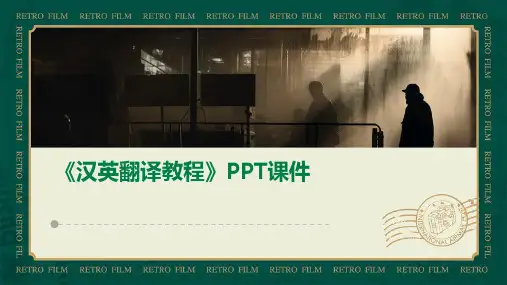
![[文学]英汉翻译实用教程第2讲_英译汉_1](https://uimg.taocdn.com/aa4f0353a417866fb84a8e8d.webp)
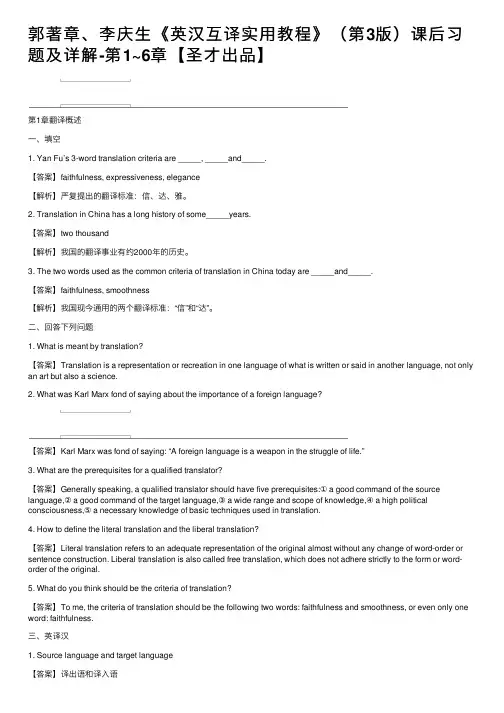
郭著章、李庆⽣《英汉互译实⽤教程》(第3版)课后习题及详解-第1~6章【圣才出品】第1章翻译概述⼀、填空1. Yan Fu’s 3-word translation criteria are _____, _____and_____.【答案】faithfulness, expressiveness, elegance【解析】严复提出的翻译标准:信、达、雅。
2. Translation in China has a long history of some_____years.【答案】two thousand【解析】我国的翻译事业有约2000年的历史。
3. The two words used as the common criteria of translation in China today are _____and_____.【答案】faithfulness, smoothness【解析】我国现今通⽤的两个翻译标准:“信”和“达”。
⼆、回答下列问题1. What is meant by translation?【答案】Translation is a representation or recreation in one language of what is written or said in another language, not only an art but also a science.2. What was Karl Marx fond of saying about the importance of a foreign language?【答案】Karl Marx was fond of saying: “A foreign language is a weapon in the struggle of life.”3. What are the prerequisites for a qualified translator?【答案】Generally speaking, a qualified translator should have five prerequisites:① a good command of the source language,② a good command of the target language,③ a wide range and scope of knowledge,④ a high political consciousness,⑤ a necessary knowledge of basic techniques used in translation.4. How to define the literal translation and the liberal translation?【答案】Literal translation refers to an adequate representation of the original almost without any change of word-order or sentence construction. Liberal translation is also called free translation, which does not adhere strictly to the form or word-order of the original.5. What do you think should be the criteria of translation?【答案】To me, the criteria of translation should be the following two words: faithfulness and smoothness, or even only one word: faithfulness.三、英译汉1. Source language and target language【答案】译出语和译⼊语2. the Oriental and Occidental languages 【答案】东⽅语⾔和西⽅语⾔3. Alexander Fraser Tyler【答案】亚历⼭⼤?弗雷泽?泰勒4. Georges Mounin【答案】乔治?穆南5. Feedorov【答案】费道罗夫6. Indu Dharmarakcha【答案】竺法护7. Kumara’3iva【答案】鸠摩罗什8. Paramartha(Gunarata)【答案】真谛/波罗末陀(拘那罗陀)【答案】利玛窦10. Euclid’s Elements【答案】《⼏何原本》11. La Dame aux Camelias【答案】《茶花⼥》12. A History of Politics(by E. Jenks)【答案】《社会通诠》(甄克思著)13. On Liberty(by J. S. Mill)【答案】《群⼰权界论》(约翰?穆勒著)14. An Inquiry Into the Nature and Cause of the Wealth of Nations(by A.Smith) 【答案】原富》(亚当?斯密)15. Evolution and Ethics and Other Essays(by T. H. Huxley)【答案】《天演论》(赫胥黎)四、汉译英【答案】faithfulness, expressiveness and elegance2. “宁顺⽽不信。
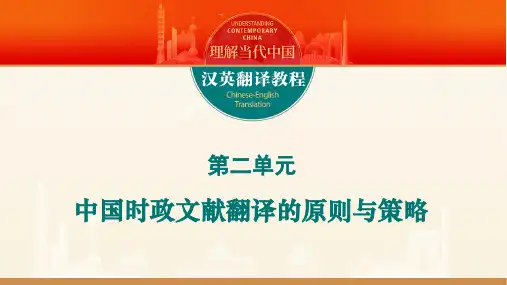
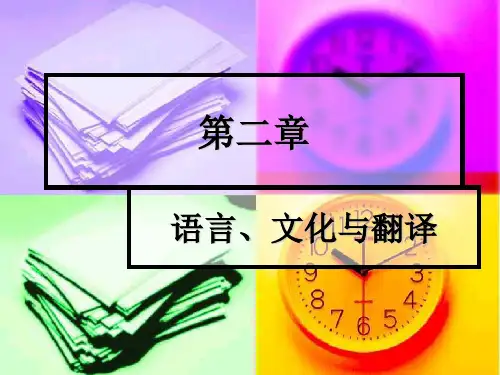
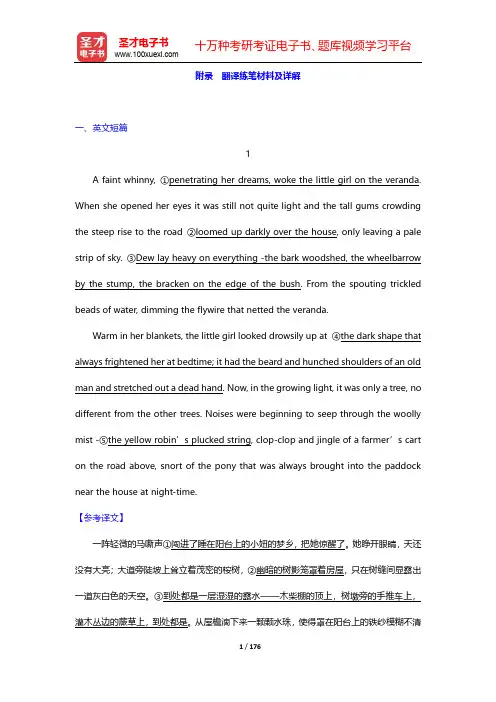
附录翻译练笔材料及详解一、英文短篇1A faint whinny, ①penetrating her dreams, woke the little girl on the veranda. When she opened her eyes it was still not quite light and the tall gums crowding the steep rise to the road ②loomed up darkly over the house, only leaving a pale strip of sky. ③Dew lay heavy on everything -the bark woodshed, the wheelbarrow by the stump, the bracken on the edge of the bush. From the spouting trickled beads of water, dimming the flywire that netted the veranda.Warm in her blankets, the little girl looked drowsily up at ④the dark shape that always frightened her at bedtime; it had the beard and hunched shoulders of an old man and stretched out a dead hand. Now, in the growing light, it was only a tree, no different from the other trees. Noises were beginning to seep through the woolly mist -⑤the yellow robin’s plucked string, clop-clop and jingle of a farmer’s cart on the road above, snort of the pony that was always brought into the paddock near the house at night-time.【参考译文】一阵轻微的马嘶声①闯进了睡在阳台上的小妞的梦乡,把她惊醒了。
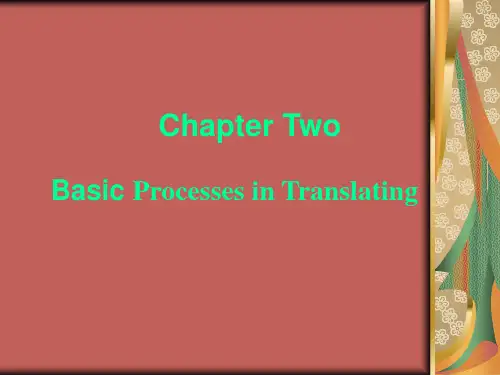
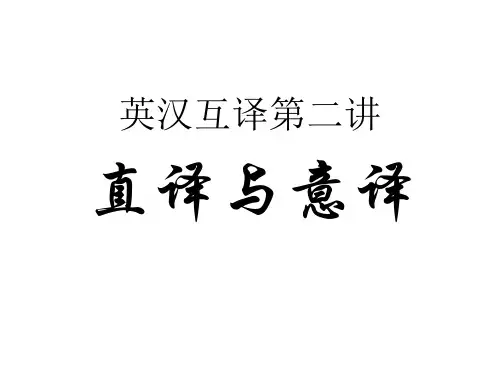
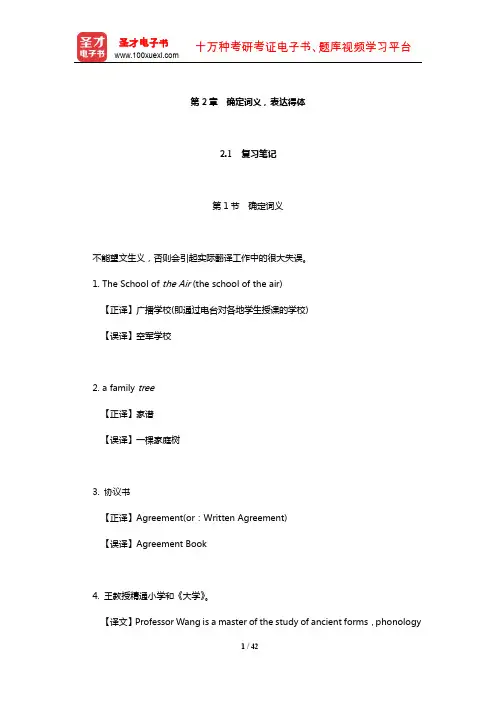
第2章确定词义,表达得体2.1 复习笔记第1节确定词义不能望文生义,否则会引起实际翻译工作中的很大失误。
1. The School of the Air (the school of the air)【正译】广播学校(即通过电台对各地学生授课的学校)【误译】空军学校2. a family tree【正译】家谱【误译】一棵家庭树3. 协议书【正译】Agreement(or:Written Agreement)【误译】Agreement Book4. 王教授精通小学和《大学》。
【译文】Professor Wang is a master of the study of ancient forms,phonologyand meaning of written language as well as of the book The Great Learning.【解析】此句中的“小学”不能译成“primary school”或“elementary school”,《大学》也不能译为什么“university”之类。
因为“小学”在此句中的意思是指研究文字古字形、训诂、音韵的学问;《大学》是我国古代经典著作《四书》之一。
第2节表达得体一、表达得体表达得体就是使译文恰如其分,不仅和原文的意思相符而且和原文的风格相符。
二、翻译中做到表达得体的方法1. 要联系上下文,这是确定词义、表达得体的基础。
2. 注意文字表达的分寸与褒贬。
3. 活用词典,即不能照抄词典上的译文。
只能根据各种词典所赋予的基本意思,融会贯通,自己创造出恰如其分的措词或词典上碰巧合适的译文。
4. 充分发挥汉语和英语的优势,使译文更地道,做到精益求精。
英、汉语各有自己的优势。
从下面例句,特别是译文中对成语的使用,可以看出汉语的优势所在。
①What we were offered was a big fat zero.我们得到的是一个大零蛋。
②Carter is shooting at oil now, but who will be next?卡特现在正拿石油开刀,下一个目标是谁呢?第3节正确理解与表达译例一、应用文方面的译例汉语中同样一个字,所处的上下文不同,译法就会各不相同:1. ××书:①申请书Letter of Application②报告书Report③协议书Agreement2. ××启事:①招领启事Found②鸣谢启事Acknowledgments③征稿启事Contributions Wanted④更正启事Corrections以上为汉译英的例子。
附录翻译练笔材料及详解一、英文短篇1A faint whinny, penetrating her dreams, woke the little girl on the veranda①. When she opened her eyes it was still not quite light and the tall gums crowding the steep rise to the road loomed up darkly over the house②, only leaving a pale strip of sky. Dew lay heavy on everything -the bark woodshed, the wheelbarrow by the stump, the bracken on the edge of the bush.③From the spouting trickled beads of water, dimming the flywire that netted the veranda.Warm in her blankets, the little girl looked drowsily up at the dark shape that always frightened her at bedtime; it had the beard and hunched shoulders of an old man and stretched out a dead hand④. Now, in the growing light, it was only a tree, no different from the other trees. Noises were beginning to seep through the woolly mist—the yellow robin’s plucked string⑤, clop-clop and jingle of a farmer’s cart on the road above, snort of the pony that was always brought into the paddock near the house at night-time.【参考译文】一阵轻微的马嘶声闯进了睡在阳台上的小妞的梦乡,把她惊醒了①。
第1章翻译概述1.1 复习笔记第1节翻译自学方法和译者合格条件一、翻译自学方法掌握必要翻译知识和理论,进行大量实践阅读翻译理论书籍、期刊,进行名著翻译实践、阅读翻译技巧书籍、浏览翻译网站等。
二、译者合格条件(一)外文水平高有些原文在特定情况下有特定译法,不能一概而论。
要特别重视基本功的训练。
1. (Just) imagine (it).【译文】不可能/想不到/没想到【解析】≠把它想象一下吧。
2. I’ll buy it.【译文】我不懂。
/我答不出。
/请告诉我。
【解析】≠我将买它。
(二)中文水平高母语好是理解和表达的需要。
理解指汉译英时理解汉语原文,表达指英译汉时可用好的汉语来表达。
(三)知识面广1. John can be relied on, he eats no fish and plays the game.【译文】约翰为人可靠,他既诚实又正直。
【解析】需要英国历史典故方面的知识。
2. The Security Council has been seized of the question since then.【译文】安理会自那时以来就一直受理这个问题。
【解析】需要国际法方面的知识。
3. Nyaungu was actually the boundary between the two Japanese divisions.【译文】良字实际上是日军两个师的结合部。
【解析】需要地理、军事等方面的知识。
(四)政治觉悟高这一点在决定用词褒贬时要特别注意。
1. the peasant uprisings in the history of China【译文】中国历史上的农民起义【解析】不能根据英国的ALD及其香港出的汉译翻成“中国历史上的农民叛乱(或叛变)”,而应译为“农民起义”。
2. The enemy killed one of our comrades and we killed an enemy agent.【译文】敌人杀害了我们一位同志,我们宰了一个敌特。
英汉互译实用教程(郭著章)第二章翻译过程及词义确定本章内容概述:翻译过程:1. 理解原文2. 译文表达3. 校核阶段翻译过程:理解原文⏹1. 理解语言现象a.词汇现象b.语法现象⏹2.理解逻辑关系⏹3.理解所涉及事物理解原文:理解语言现象译者必须上下有联系地理解原文的词汇含义、句法结构和惯用法等理解原文:理解语言现象a.词汇现象:根据上下文确定词义⏹Eg.1. Life is full of ups and downs.人生充满了欢乐与痛苦。
⏹He has seen the ups and downs in the history of ⏹the relations between the two countries.⏹他经历了两国关系史上的分分合合。
a.词汇现象:根据上下文确定词义Eg. 2. The wedding ,which Heyward still remembered with pride ,was attended by a who's who of Boston Society.赫华德仍然记得,参加婚礼的人中有波士顿的一位社会名流,这使他感到十分得意。
a.词汇现象:根据上下文确定词义Eg.3. There was no lady about him. He was what the woman would call a manly man. That was why they like him.他这人没有一点女人气。
他是女人们称之为男子汉的那种人。
这正是他们喜欢他的原因所在。
a.词汇现象:根据上下文确定词义4. My handwriting was so bad that after taking dictation, I couldn’t translate it.辨识、辨认a.词汇现象:根据词性确定词义Eg.5. On his way home he bought some apples at a fruit stand.摊位他回家时,在路上的水果摊上买了些苹果。
a.词汇现象:根据词性确定词义Eg.6. I think, however, that, provided work is not excessive in amount, even the dullest work is to most people less painful than idleness.因此该句可译为:“然而,我认为,对大多数人来说,只要工作量不是太大,即使所做的事再单调也总比无所事事好受。
”a.词汇现象:根据词性确定词义◆Eg.7.The ship righteditself after the big wavehad passed.◆大浪过后,船又平稳了。
(动词)a.词汇现象:根据搭配习惯确定词义Eg.8. He once again imparted to us great knowledge, experience and wisdom.我们又一次领受了他的广博知识,丰富的经验和无穷的智慧。
1.Her whole attitude had had a subtle change.2.There are subtle differences in meaning between these two words.3. I fall for that subtle plot every time!4. An artist has subtler awareness of color values than an ordinary person.5. The old craftsman has subtle fingers.微妙的细微的诡秘的敏锐的灵巧的a.词汇现象:根据搭配习惯确定词义Eg.9. subtlea.词汇现象:根据搭配习惯确定词义Eg.10. …yet, as it sometimes happens that a person departs his life, who is really deserving of the praises the stone-cutter carves over his bones; who is a good Christian, a good parent, a good child, a good wife or a good husband;who actually does have a disconsolate family to mourn his loss; ………不过偶尔也有几个死人当得起石匠刻在他们朽骨上的好话。
真的是虔诚的教徒,慈爱的父母,孝顺的儿女,贤良的妻子,尽职的丈夫,他们家里人也的确绵绵地追悼他们。
……a.词汇现象:根据感情色彩确定词义Eg.11. It was mid-August and the subject for discussion was the future of Rommel and his African Corps.当时是八月中旬,他们讨论的题目是隆美尔及其非洲军团的下场。
They became less discouraged when they realized they themselves can make a better future.当他们意识到他们可以创造更美好的前程时,他们不在灰心丧气。
理解原文:理解语言现象a.词汇现象:根据词形变换确定词义◆要注意的是,英语中有些名词单复数形式的意思大相径庭。
试比较下面名词两种形式的不同含义:◆1.work工作,works工厂、著作。
◆2.time时间,times时代。
◆3.letter字母、信,letters文学。
◆4.force力量,forces军队。
理解原文:理解语言现象a.词汇现象:根据词形变换确定词义◆5.paper纸,papers文件、证件。
◆6.air空气,airs做作的姿态。
◆7.manner方式,manners礼貌。
◆8.return归还,returns利润。
◆9.authority权力,authorities当局。
◆10. ground地、场地,grounds理由。
理解原文:理解语言现象译文:“当您认识您的杰出事业是如此广泛地受到人们的尊敬和赞赏时,您就会为自己增添力量。
”Eg.1.It will strengthenyou to know that yourdistinguished career isso widely respectedand appreciated . b.语法现象理解原文:理解语言现象b.语法现象Eg.2. John is now with his parents in New York City; it is already three years sincehe was a bandmaster译文:约翰现与父母同住在纽约市;他不担任乐队指挥已经三年了。
理解原文:理解语言现象:语法3.With two young children and a husband…,I took a chance. (Para: 8)我接受了这份工作。
took the chanceb.语法现象我只能先接受这份工作,以等待更好的机会。
为透彻理解原文,译者往往必须上下有联系地理解原文的逻辑关系。
有时一个词,一个词组或一个句子可能有几种不同的意思,要仔细推敲,分析来龙去脉,根据逻辑推理来决定那种译法正确。
逻辑关系有时能帮助我们理解按原文语法关系所不能理解的问题。
2)他这样做是件好事。
1)这样做对他有好处Eg. 1. It is good for him to do that.理解原文:理解逻辑关系Eg. 2. She didn’t marry he because she loved her.1)她没有与他结婚,因为她爱他。
(她不愿意连累他?)2)他不是因为爱他才与他结婚的。
(为财产?地位,也许是为惩罚他!)理解原文:理解逻辑关系有人在抽烟,学生们在校园里被号召去制止他们学生们在校内抽烟,校方让他们停止这样做有人在抽烟,学生们被告知去制止他们在校园内抽烟。
(要抽可以去校外)The students were asked tostop smoking oncampus.校方要求学生们不要在校园内抽烟校方禁止学生抽烟。
有人在校内抽烟,校方请学生们去制止他们Eg.3理解原文:理解原文所涉及的事物往往有这样一种情况,译者能正确地分析原文的语言现象和逻辑关系,但由于对所涉及的具体客观事物,特别是一些特有的事物、历史背景、典故或专门术语不了解,所以就翻译不出,或勉强译出别人也不知所云。
Eg.1. John can be relied on. He eats no fish and plays the game.“忠诚”为人正直,光明正大“约翰既忠诚又正直,可以信赖。
”(1) 《欲望都市》般的生活(2) 灯红酒绿的城市生活(3) 奢侈淫逸的生活?(4) 空虚寂寥的城市生活(5) 小市民般的世俗生活(6) 过着糜烂的城市生活(7) 性感而城市化的生活(8) 纸醉金迷的城市生活(9) ……接下来的六个月,我就像电视剧《欲望都市》里的四个女主角一样——在这充满欲望和诱惑的都市里,寻找着自己的归宿。
Eg.2. For six months, I was living the Sex and the City life.他吃了大败仗Eg.4. He met his Waterloo.meet one's Waterloo 是成语典故,由拿破仑在Waterloo 遇到惨败而来Eg.5. He is not Hamlet.他不是那种优柔寡断的人。
翻译过程:译文表达表达是指译者把自己对原文内容的理解用本族语/或另一种语言重新表达出来。
表达的好坏主要决定于对原文理解的深度和对译文语言的修养程度和驾驭能力。
表达是理解的结果,但理解正确并不一定意味着表达得正确。
翻译过程:译文表达译文表达方法意译liberal translation(点击连接)直译literal translation(点击连接)(点击连接)翻译过程:译文表达直译(literal translation) Literal translation: A rendering which preserves surface aspects of the message both semantically and syntactically, adhering closely to source text mode of expression.意译(Free Translation )Free Translation, on the other hand, modifies surface expression and keeps intact only deeper levels of meaning. The choice of either method of translation is determined by text properties to do with text type, purpose of translation, etc.直译就是在译文语言条件许可下,在译文中既保持原文的内容,又保持原文的形式——特别指保持原文的比喻、形象和民族特色。